 |
|
|
|
|
|
|
|
|
|
|
|
|
|
|
|
|
||||
| ||||||||||
|
|
|
|
Malaria Surveillance --- United States, 2003M. James Eliades, MD,1,2 Snehal Shah,
MD,1,2 Phuc Nguyen-Dinh,
MD,2 Robert D. Newman, MD,2 Ann M.
Barber,2 Corresponding author: Melto James Eliades, National Center for Infectious Diseases, 4770 Buford Highway, MS F-22, Chamblee 30341; Telephone: 770-488-7793; Fax: 770-488-4206; E-mail: bvz9@cdc.gov. AbstractProblem/Condition: Malaria in humans is caused by any of four species of intraerythrocytic protozoa of the genus Plasmodium (i.e., P. falciparum, P. vivax, P. ovale, or P. malariae). These parasites are transmitted by the bite of an infective female Anopheles sp. mosquito. The majority of malaria infections in the United States occur among persons who have traveled to areas with ongoing transmission. In the United States, cases can also occur through exposure to infected blood products, by congenital transmission, or by local mosquitoborne transmission. Malaria surveillance is conducted to identify episodes of local transmission and to guide prevention recommendations for travelers. Period Covered: This report covers cases with onset of illness in 2003, and summarizes trends over previous years. Description of System: Malaria cases confirmed by blood film are mandated to be reported to local and state health departments by health-care providers or laboratory staff. Case investigations are conducted by local and state health departments, and reports are transmitted to CDC through the National Malaria Surveillance System (NMSS). Data from NMSS serve as the basis for this report. Results: CDC received reports of 1,278 cases of malaria with an onset of symptoms in 2003, including seven fatal cases, among persons in the United States or one of its territories. This number represents a decrease of 4.4% from the 1,337 cases reported for 2002. P. falciparum, P. vivax, P. malariae, and P. ovale were identified in 53.3%, 22.9%, 3.6%, and 2.6% of cases, respectively. Twelve patients (0.9% of total) were infected by two or more species. The infecting species was unreported or undetermined in 212 (16.6%) cases. Compared with 2002, the number of reported malaria cases acquired in Asia (n = 177) and the Americas (n = 147) increased by 3.5% and 4.3% respectively, whereas the number of cases acquired in Africa (n = 840) decreased by 7.0%. Of 762 U.S. civilians who acquired malaria abroad, 132 (17.3%) reported that they had followed a chemoprophylactic drug regimen recommended by CDC for the area to which they had traveled. Ten patients became infected in the United States, including one probable transfusion-related, one in which epidemiologic investigations failed to identify any apparent mode of acquisition, and eight which were introduced cases as a result of local mosquitoborne transmission. Of the seven deaths attributed to malaria, five were caused by P. falciparum, and a species was not identified in the other two. Interpretation: The 4.4% decrease in malaria cases in 2003, compared with 2002, resulted primarily from a decrease in cases acquired in Africa, but this decrease was offset by an increase in the number of cases acquired in the Americas and Asia. This small decrease probably represents year-to-year variation in malaria cases, but also could have resulted from local changes in disease transmission, decreased travel to malaria-endemic regions, or fluctuation in reporting to state and local health departments. In the majority of reported cases, U.S. civilians who acquired infection abroad were not on an appropriate chemoprophylaxis regimen for the country in which they acquired malaria. Public Health Actions: Additional information was obtained concerning the seven fatal cases and the 10 infections acquired in the United States. Persons traveling to a malarious area should take one of the recommended chemoprophylaxis regimens appropriate for the region of travel, and travelers should use personal protection measures to prevent mosquito bites. Any person who has been to a malarious area and who subsequently experiences a fever or influenza-like symptoms should seek medical care immediately and report their travel history to the clinician; investigation should include a blood-film test for malaria. Malaria infections can be fatal if not diagnosed and treated promptly. Recommendations concerning malaria prevention can be obtained from CDC by calling the Malaria Hotline at 770-488-7788 or by accessing CDC's Internet site at http://www.cdc.gov/travel. Recommendations concerning diagnosis of malaria and its treatment can be obtained by calling the Malaria Hotline or accessing CDC's Internet site at http://www.cdc.gov/malaria/diagnosis_treatment/treatment.htm. IntroductionMalaria is caused by infection with one or more of four species of Plasmodium (i.e., P. falciparum, P. vivax, P. ovale, and P. malariae) that can infect humans. Other Plasmodium species infect animals. The infection is transmitted by the bite of an infective female Anopheles sp. mosquito. Malaria infection remains a devastating global problem, with an estimated 300--500 million cases occurring annually (1). Forty-one percent of the world's population lives in areas where malaria is transmitted (e.g., parts of Africa, Asia, the Middle East, Central and South America, Hispaniola, and Oceania) (1), and 700,000--2.7 million persons die of malaria each year, 75% of them African children (2). Before the 1950s, malaria was endemic throughout the southeastern United States; an estimated 600,000 cases occurred in 1914 (3). During the late 1940s, a combination of improved housing and socioeconomic conditions, water management, vector-control efforts, and case management was successful at interrupting malaria transmission in the United States. Since then, malaria case surveillance has been maintained to detect locally acquired cases that could indicate the reintroduction of transmission and to monitor patterns of antimalarial drug resistance. Anopheline mosquitos remain seasonally present in all states and territories except Guam and Hawaii. The majority of reported cases of malaria each year diagnosed in the United States have been imported from regions of the world where malaria transmission is known to occur, although congenital infections and infections resulting from exposure to blood or blood products are also reported in the United States. In addition, a limited number of cases are reported that might have been acquired through local mosquitoborne transmission (4), typically <1% per year. State and local health departments and CDC investigate malaria cases acquired in the United States, and CDC analyzes data from imported cases to detect trends in acquisition. This information is used to guide malaria-prevention recommendations for international travelers. For example, an increase in P. falciparum malaria among U.S. travelers to Africa, an area with increasing chloroquine resistance, prompted CDC to change the recommended chemoprophylaxis regimen from chloroquine to mefloquine in 1990 (5). The signs and symptoms of malaria illness are varied, but the majority of patients experience fever. Other common symptoms include headache, back pain, chills, sweating, myalgia, nausea, vomiting, diarrhea, and cough. The diagnosis of malaria should be considered for persons who experience these symptoms and who have traveled to an area with known malaria transmission. Malaria should also be considered in the differential diagnoses of persons who experience fevers of unknown origin, regardless of their travel history. Untreated P. falciparum infections can rapidly progress to coma, renal failure, pulmonary edema, and death. Asymptomatic parasitemia can occur, most commonly among persons who have been long-term residents of areas where malaria is endemic. This report summarizes malaria cases reported to CDC with onset of symptoms in 2003. MethodsData SourcesMalaria case data are reported to the National Malaria Surveillance System (NMSS) and the National Notifiable Diseases Surveillance System (6). Although both systems rely on passive reporting, the numbers of reported cases might differ because of differences in collection and transmission of data. A substantial difference in the data collected in these two systems is that NMSS receives more detailed clinical and epidemiologic data about each case (e.g., information about the area to which the infected person has traveled). This report presents only data about cases reported to NMSS. Cases of blood-film--confirmed malaria among civilians and military personnel are identified by health-care providers or laboratories. Each slide-confirmed malaria case is reported to local or state health departments and to CDC on a uniform case report form that contains clinical, laboratory, and epidemiologic information. CDC staff review all report forms when received and request additional information from the provider or the state, if necessary (e.g., when no recent travel to a malarious country is reported). Reports of other cases are telephoned to CDC directly by health-care providers, usually when they are seeking assistance with diagnosis or treatment. Cases reported directly to CDC are shared with the relevant state health department. All cases that have been acquired in the United States are investigated, including all induced and congenital cases and possible introduced or cryptic cases. Information derived from uniform case report forms is entered into a database and analyzed annually. U.S. military and civilian cases diagnosed outside of the United States and its territories are not reported through this system and are not included in this report. DefinitionsThe following definitions are used in this report:
This report also uses terminology derived from the recommendations of the World Health Organization (7). Definitions of the following terms are included for reference:
Microscopic Diagnosis of MalariaThe early and prompt diagnosis of malaria requires that physicians obtain a travel history from every febrile patient. Malaria should be included in the differential diagnosis of every febrile patient who has traveled to an area where malaria is endemic. If malaria is suspected, a Giemsa-stained film of the patient's peripheral blood should be examined for parasites. Thick and thin blood films must be prepared correctly because diagnostic accuracy depends on blood-film quality and examination by experienced laboratory personnel* (Appendix). ResultsGeneral SurveillanceFor 2003, CDC received 1,278 malaria case reports occurring among persons in the United States and its territories, representing a 4.4% decrease from the 1,337 cases reported with a date of onset in 2002 (8) (Table 1). In 2003, a total of 767 cases occurred among U.S. civilians and 306 cases among foreign civilians (Table 1). In recent years, cases among U.S. civilians have increased and cases among foreign-born civilians have decreased (Figure 1). These trends are probably a result of increased travel among U.S. citizens and decreased immigration since 2001. Plasmodium SpeciesThe infecting species of Plasmodium was identified in 1,066 (83.4%) of the cases reported in 2003. P. falciparum and P. vivax were identified in blood films from 53.4% and 22.9% of infected persons, respectively (Table 2). The 682 P. falciparum cases reported for 2003 represented a 2.4% decrease from the 699 cases in 2002, and the number of P. vivax infections decreased by 13.6% (from 339 in 2002 to 293 in 2003). Among 1,015 cases in which both the region of acquisition and the infecting species were known, 83.5 % of infections acquired in Africa were attributed to P. falciparum; 7.0% were attributed to P. vivax. The converse was true of infections acquired in the Americas and Asia: 62.9% and 80.4% were attributed to P. vivax, and 31.5% and 12.0% were attributed to P. falciparum, respectively. Region of Acquisition and DiagnosisAll but 10 reported cases (n = 1,268) were imported. Of 1,201 imported cases in which the region of acquisition was known, the majority (70.0%; n = 840) were acquired in Africa; 14.7 % (n = 177) and 12.3% (n = 147) were acquired in Asia and the Americas, respectively (Table 3). A limited number of imported cases were acquired in Oceania (3.1%; n = 37). The highest concentration of cases acquired in Africa came from countries in West Africa (67.5%; n = 567); a substantial percentage of cases acquired in Asia came from the Indian subcontinent (56.5%; n = 100). From within the Americas, the majority of cases were acquired in Central America and the Caribbean (63.9%; n = 94), followed by South America (21.8%; n = 32) and Mexico (14.3% n=21). Information about region of acquisition was missing for 67 (5.3%) of the imported cases. Compared with 2002, the number of reported malaria cases acquired in Asia and the Americas increased by 3.5% and 4.3% respectively, and the number of cases acquired in Africa decreased 7.0%. In the United States, the six health departments reporting the highest number of malaria cases were New York City (n = 191), California (n = 155), Florida (n = 86), Maryland (n = 73), Georgia (n = 68), and New York State (n = 68) (Figure 2). The majority of these health departments reported a decrease in cases compared with 2002, consistent with the overall decrease in cases occurring nationwide. This decrease probably represents year-to-year variation in malaria cases rather than a trend, but could also have resulted from local changes in disease transmission abroad, decreased travel to malaria-endemic regions, or fluctuation in reporting to state and local health departments. Interval Between Arrival and IllnessThe interval between date of arrival in the United States and onset of illness and the infecting Plasmodium species was known for 640 (50.5 %) of the imported malaria cases (Table 4). Symptoms began before arrival in the United States for 77 (12.0%) persons, and symptoms began after arrival in the United States for 563 (88.0%) persons. Clinical malaria occurred within 1 month after arrival in 363 (79.4%) of the 457 persons with P. falciparum cases and in 57 (42.2%) of the 135 persons with P. vivax cases (Table 4). Only five (0.8%) of the 640 persons became ill >1 year after returning to the United States. Imported Malaria CasesImported Malaria Among U.S. Military Personnel In 2003, a total of 36 cases of imported malaria was reported among U.S. military personnel. These cases were reported by state health departments. Of these, 28 (77.8%) had been acquired in Asia, five (13.9%) in the Americas, two (5.6%) in Africa, and one (2.8%) in Oceania. This is similar to the distribution of cases in 2002. Imported Malaria Among Civilians A total of 1,066 imported malaria cases were reported among civilians. Of these, 761 (71.4%) occurred among U.S. residents, and 305 (28.6%) cases occurred among residents of other countries (Table 5). Of the 761 imported malaria cases among U.S. civilians, 561 (73.7%) had been acquired in Africa, a decrease of 12.5% from cases reported in 2002. Asia accounted for 83 (10.9%) cases of imported malaria among U.S. civilians, and travel to the Central American and Caribbean regions accounted for 59 (7.6%) cases. Of the 305 imported cases among foreign civilians, the majority of cases were acquired in Africa (n = 202; 66.2%). Antimalarial Chemoprophylaxis UseChemoprophylaxis Use Among U.S. Military Personnel Information about chemoprophylaxis use and travel area was known for 33 (91.7%) of the 36 U.S. military personnel who had imported malaria. Of these 33 persons, eight (24.2%) were not using any chemoprophylaxis, two (6.1%) had not taken a CDC-recommended drug for the area visited, and 23 (69.7%) took a CDC-recommended medication. Of the 23 U.S. military personnel who took a CDC-recommended medication for the area visited, 10 (43.5%) reported taking doxycycline daily, two of those in combination with primaquine for terminal prophylaxis; seven (30.4%) had taken mefloquine weekly, one in combination with primaquine; four (17.4%) who had traveled to areas where chloroquine-resistant malaria has not been documented had taken chloroquine weekly, three in combination with primaquine; none had taken atovaquone-proguanil; and two (8.7%) had taken a combination of drugs that included more than one CDC-recommended medication for the travel region. Chemoprophylaxis Use Among U.S. Civilians Information about chemoprophylaxis use and travel area was known for 709 (93.2%) of the 761 U.S. civilians who had imported malaria. Of these 709 persons, 445 (62.8%) had not taken any chemoprophylaxis, and 111 (15.7%) had not taken a CDC-recommended drug for the area visited (9). Only 132 (18.6%) U.S. civilians had taken a CDC-recommended medication (9). Data for the specific drug taken were missing for the remaining 21 (3.0%) travelers. A total of 85 (64.4%) patients on CDC-recommended prophylaxis had reported taking mefloquine weekly; 35 (26.5%) had taken doxycycline daily; none had taken atovaquone-proguanil daily; and five (3.8%) who had traveled only in areas where chloroquine-resistant malaria has not been documented had taken chloroquine weekly. Information about adherence to the drug regimen for these persons is presented in the following section. Seven patients (5.3%) had taken combinations of drugs that included one or more CDC-recommended drug for the travel region. Of the 111 patients taking a nonrecommended drug, 47 (42.3%) reported taking chloroquine either alone or in combination with another ineffective drug during travel to an area where chloroquine resistance has been documented. Malaria Infection After Recommended Prophylaxis Use A total of 167 patients (132 U.S. civilians, 23 persons in the U.S. military, six foreign civilians, and six persons whose information about their status was missing) contracted malaria after taking a recommended antimalarial drug for chemoprophylaxis. Of these, 58 (34.7%) reported compliance with the regimen, 79 (47.3%) reported noncompliance, and compliance was unknown for the remaining 30 (18.0%). Information about infecting species was available for 131 (78.4%) patients taking a recommended antimalarial drug; the infecting species was undetermined for the remaining 36. Cases of P. vivax or P. ovale After Recommended Prophylaxis Use. Of the 167 patients who had malaria diagnosed after recommended chemoprophylaxis use, 65 (38.9 %) had cases that were caused by P. vivax and three (1.8%) by P. ovale. A total of 18 (26.5%) cases of P. vivax or P. ovale occurred >45 days after arrival in the United States. These cases were consistent with relapsing infections and do not indicate primary prophylaxis failures. Information was insufficient because of missing data about symptom onset or return date to assess whether 34 cases were relapsing infections. Sixteen cases, 15 by P. vivax and one by P. ovale, occurred <45 days after the patient returned to the United States. Nine of the 16 patients were known to be noncompliant with their antimalarial chemoprophylaxis regimen. Four patients reported compliance with an antimalarial chemoprophylaxis regimen. Of these four, one had traveled to Asia, one to sub-Saharan Africa, and two to South America. One of these patients reported taking mefloquine and three reported using doxycycline. Blood samples for serum drug levels were not available for these four patients. The possible explanations for these cases include inappropriate dosing, noncompliance that was not reported, malabsorption of the drug, or emerging parasite resistance. For the remaining three patients, no information was available about compliance. The region of acquisition varied for these three patients (one from Ethiopia, one from Mexico, and one from Papua New Guinea). Cases of P. falciparum and P. malariae after Recommended Prophylaxis Use. The remaining 99 cases of malaria reported among persons who had taken a recommended antimalarial drug for chemoprophylaxis include 54 cases of P. falciparum, six cases of P. malariae, three cases of mixed infection, and 36 cases in which the infecting species was unidentified. A total of 52 of the 54 P. falciparum cases among those who reported taking a recommended antimalarial drug were acquired in Africa and two in South America. In 33 (61.1%) of these 54 cases, noncompliance with antimalarials was reported. In 14 (26.0%) of these 54 cases, patients reported compliance with antimalarial chemoprophylaxis. All 14 of these patients had traveled to Africa. Thirteen had reported taking mefloquine, and one had reported taking doxycycline for malaria chemoprophylaxis. Blood samples were not available for the 14 patients who reported compliance with a recommended regimen. Seven cases of P. falciparum were identified for which patient compliance was unknown. Five of the six P. malariae cases among those who reported taking a recommended antimalarial drug were acquired in Africa. Two (40.0%) of these patients reported noncompliance with antimalarials, and two (40.0%) patients reported compliance with a recommended chemoprophylaxis regimen. One of the compliant patients had used doxycycline and the other one used mefloquine; one had traveled to Africa and one to Asia and blood samples were not available. Purpose of TravelPurpose of travel to malaria-endemic areas was reported for 692 (90.9%) of the 761 U.S. civilians with imported malaria (Table 6). Certain cases reported more than one purpose of travel. Of the U.S. civilians with malaria, the largest proportion (53.9%) was persons who had visited friends or relatives in malarious areas; the second and third highest proportion, 12.5% and 9.2%, had traveled for tourism and to do missionary work, respectively. Malaria During PregnancyA total of 31 cases of malaria were reported among pregnant women in 2003, representing 7.0% of cases among women. Eighteen of the 31 (58.1%) were among U.S. civilians; all 18 had traveled to Africa and 14 of the 18 women had traveled to visit friends and relatives. Of the remaining 13, a total of 12 were foreign civilians. Approximately 13% of pregnant women and 28.2% of nonpregnant women reported taking malaria chemoprophylaxis. Malaria Acquired in the United StatesCryptic Malaria One case of cryptic malaria was reported in 2003 and is described in the following case report:
Induced Malaria One case of induced malaria, caused by blood transfusion, was reported in 2003 and is described in the following case report:
Introduced Malaria Eight cases of introduced malaria were reported in 2003 (10). The cases occurred in Palm Beach County, Florida, and PCR demonstrated the same strain for all eight cases. They are described in the following case reports:
Deaths Attributed to MalariaSeven deaths attributable to malaria were reported in 2003 and are described in the following case reports:
DiscussionA total of 1,278 cases of malaria were reported to CDC for 2003, representing a 4.4% decrease from the 1,337 cases reported for 2002. This change primarily resulted from a decrease in cases acquired in Africa. Since 2000, CDC has routinely contacted state health departments to ask for outstanding malaria case reports from the previous reporting year or for a statement that reporting is complete. The decrease in cases in 2003, compared with 2002, most likely does not represent a true trend. Possible explanations for a decrease include decreased international travel or changing patterns of travel (e.g., decreased immigration from malarious areas). One reason for conducting malaria surveillance is to monitor for prophylaxis failures that might indicate emergence of drug resistance; however, approximately 82.7% of imported malaria among U.S. civilians occurred among persons who were either not taking prophylaxis or were taking nonrecommended prophylaxis for the region to which they were traveling. Among patients for whom appropriate prophylaxis was reported and for whom adequate information was available about species and onset of symptoms to indicate that the infection was a primary one rather than a relapse, the majority reported noncompliance with recommended regimen or had insufficient information to determine whether these cases represented problems with adherence while using correct antimalarial chemoprophylaxis, malabsorption of the antimalarial drug, or emerging drug resistance. Among patients who reported compliance with a recommended regimen, serum drug levels were not available. Therefore, differentiating among inaccurate reporting of compliance, malabsorption of the antimalarial drug, and emerging drug resistance is impossible. No conclusive evidence existed to indicate a single national or regional source of infection among this group of patients or the failure of a particular chemoprophylactic regimen. Health-care providers should contact CDC rapidly whenever they suspect chemoprophylaxis failure, thus enabling measurement of serum drug levels of the antimalarial drugs in question. The importance of taking correct precautions and chemoprophylaxis is underscored by the seven fatal cases of malaria that occurred in the United States in 2003. An earlier review of deaths attributed to malaria in the United States indicated that failure to take or adhere to recommended antimalarial chemoprophylaxis, to promptly seek medical care for posttravel illness, and to promptly diagnose and treat suspected malaria all contributed to fatal outcomes (11). The occurrence of 18 cases of malaria among pregnant U.S. civilians is also cause for concern. Malaria during pregnancy among nonimmune women is more likely to result in severe disease or contribute to an adverse outcome than malaria in nonpregnant women (12). In addition, the fetus might be adversely affected (13). Pregnant travelers should be counseled to avoid travel to malarious areas. If deferral of travel is impossible, pregnant women should be informed that the risks for malaria outweigh those associated with prophylaxis and that safe chemoprophylaxis regimens are available. Specific guidance for pregnant travelers is available at http://www.cdc.gov/travel/mal_preg_pub.htm. The eight cases of introduced malaria in Florida demonstrate the potential for reintroduction of malaria into the United States. Of the 10 species of Anopheles mosquitoes found in the United States, the two species that were responsible for malaria transmission before eradication (Anopheles quadrimaculatus in the east and An. freeborni in the west) are still widely prevalent. Intensive surveillance, rapid recognition, accurate diagnosis, and appropriate case management are essential for limiting the spread of a malaria outbreak. Signs and symptoms of malaria are often nonspecific, but fever is usually present. Other symptoms include headache, chills, increased sweating, back pain, myalgia, diarrhea, nausea, vomiting, and cough. Prompt diagnosis requires that malaria be included in the differential diagnosis of illness in a febrile person with a history of travel to a malarious area. Clinicians should ask all febrile patients for a travel history, including international visitors, immigrants, refugees, migrant laborers, and international travelers. Prompt treatment of suspected malaria is essential because persons with P. falciparum infection are at risk for life-threatening complications soon after the onset of illness. Ideally, therapy for malaria should be initiated immediately after the diagnosis has been confirmed by a positive blood film. Treatment should be determined on the basis of the infecting Plasmodium species, the probable geographic origin of the parasite, the parasite density, and the patient's clinical status (14). If the diagnosis of malaria is suspected and cannot be confirmed, or if a diagnosis of malaria is confirmed but species determination is not possible, antimalarial treatment should be initiated that is effective against P. falciparum. Resistance of P. falciparum to chloroquine is worldwide, with the exception of a limited number of geographic regions (e.g., Central America). Therefore, therapy for presumed P. falciparum malaria should usually entail the use of a drug effective against such resistant strains. Health-care providers should be familiar with prevention, recognition, and treatment of malaria and are encouraged to consult appropriate sources for malaria prevention and treatment recommendations (Table 7). Physicians seeking assistance with the diagnosis or treatment of patients with suspected or confirmed malaria should call CDC's National Center for Infectious Diseases, Division of Parasitic Diseases (770-488-7788) during regular business hours or the CDC's Emergency Operations Center (770-488-7100) during evenings, weekends, and holidays (ask to page person on call for Malaria Branch), or access CDC's Internet site at http://www.cdc.gov/malaria/diagnosis_treatment/treatment.htm. These resources are intended for use by health-care providers only. Detailed recommendations for preventing malaria are available to the general public 24 hours a day from CDC by telephone (877-394-8747 [toll-free voice information system] or 888-232-3299 [toll-free facsimile request line]) or on the Internet (http://www.cdc.gov/travel/diseases.htm/malaria). In addition, CDC biannually publishes recommendations in Health Information for International Travel (commonly referred to as The Yellow Book) (10), which is available for purchase from the Public Health Foundation at 877-252-1200 or 301-645-7773; it is also available and updated more frequently on CDC's Internet site at http://www.cdc.gov/travel. CDC provides technical support for health-care providers in the diagnosis of malaria through DPDx, a progra9m that enhances diagnosis of parasitic diseases throughout the world. It includes an Internet site (http://www.dpd.cdc.gov/dpdx) that contains information about laboratory diagnosis, geographic distribution, clinical features, treatment, and life cycles of more than 100 different parasite species, including malaria parasites. The DPDx Internet site is also a portal for diagnostic assistance for health-care providers through telediagnosis. Digital images captured from diagnostic specimens are submitted for diagnostic consultation through e-mail. Because laboratories can transmit images to CDC and rapidly obtain answers to their inquiries, this system allows efficient diagnosis of difficult cases and rapid dissemination of information. Approximately 46 public health laboratories in 41 states, Puerto Rico, and Guam have or are in the process of acquiring the hardware to perform telediagnosis. Acknowledgments The authors acknowledge the state, territorial, and local health departments; health-care providers; and laboratories for reporting this information to CDC. References
* To obtain confirmation diagnosis of blood films from questionable cases and to obtain appropriate treatment recommendations, contact either your state or local health department or CDC's National Center for Infectious Diseases, Division of Parasitic Diseases, Malaria Branch at 770-488-7788. Table 1 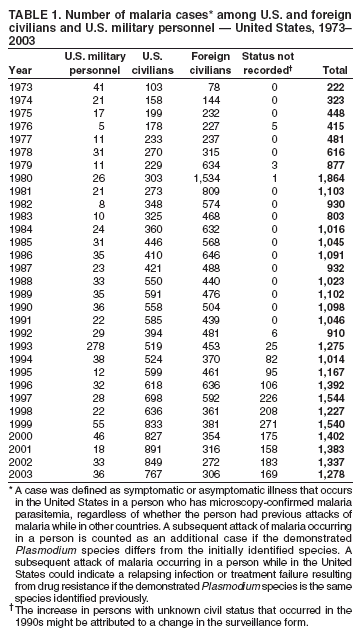 Return to top. Figure 1 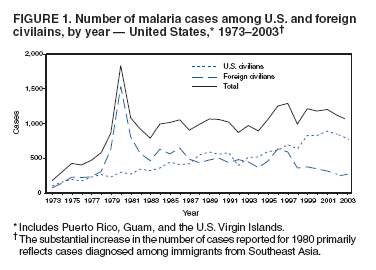 Return to top. Table 2  Return to top. Figure 2 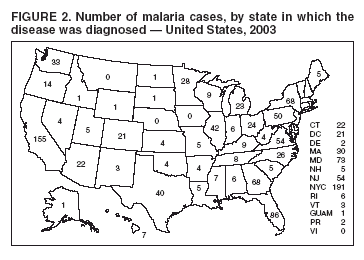 Return to top. Table 3 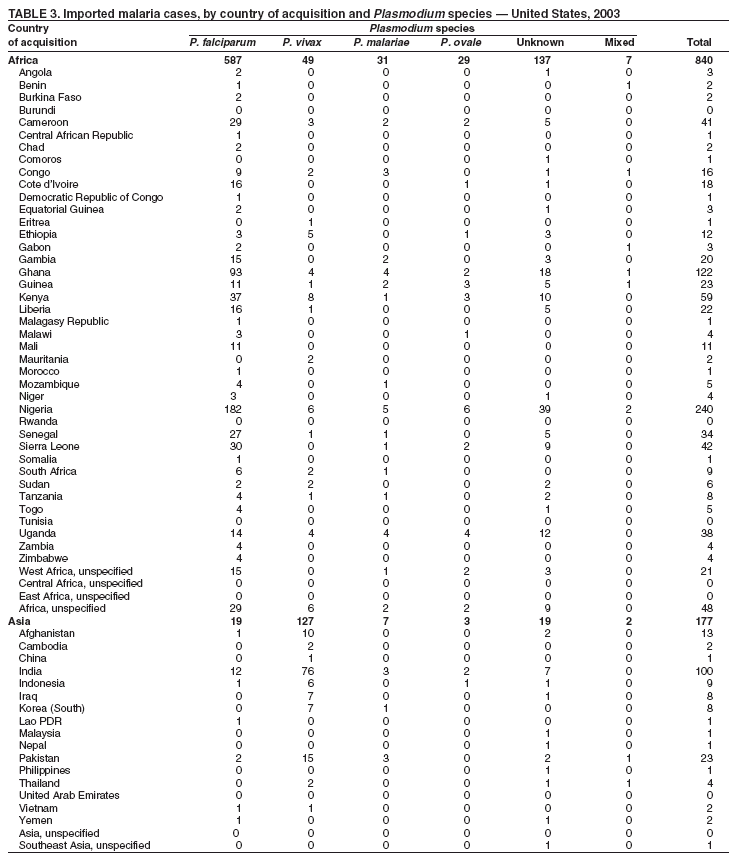 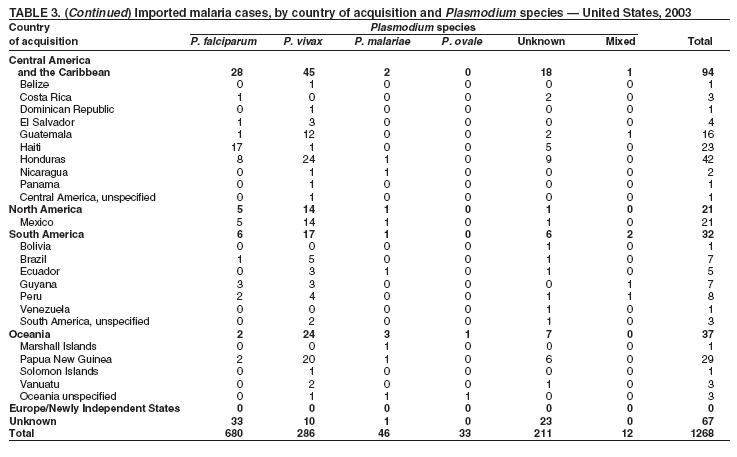 Return to top. Table 4  Return to top. Table 5  Return to top. Table 6 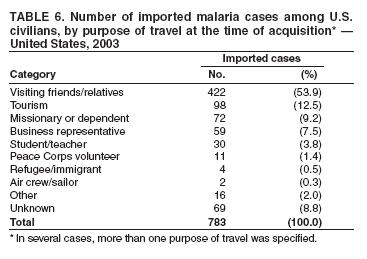 Return to top. Table 7 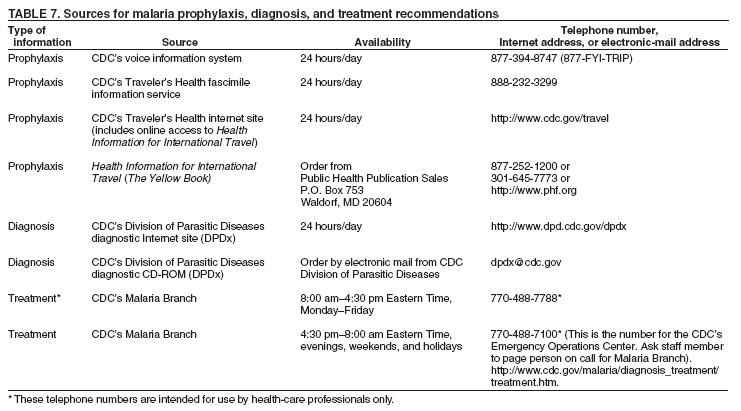 Return to top.
All MMWR HTML versions of articles are electronic conversions from ASCII text into HTML. This conversion may have resulted in character translation or format errors in the HTML version. Users should not rely on this HTML document, but are referred to the electronic PDF version and/or the original MMWR paper copy for the official text, figures, and tables. An original paper copy of this issue can be obtained from the Superintendent of Documents, U.S. Government Printing Office (GPO), Washington, DC 20402-9371; telephone: (202) 512-1800. Contact GPO for current prices. **Questions or messages regarding errors in formatting should be addressed to mmwrq@cdc.gov.Date last reviewed: 5/31/2005 |
|||||||||
|